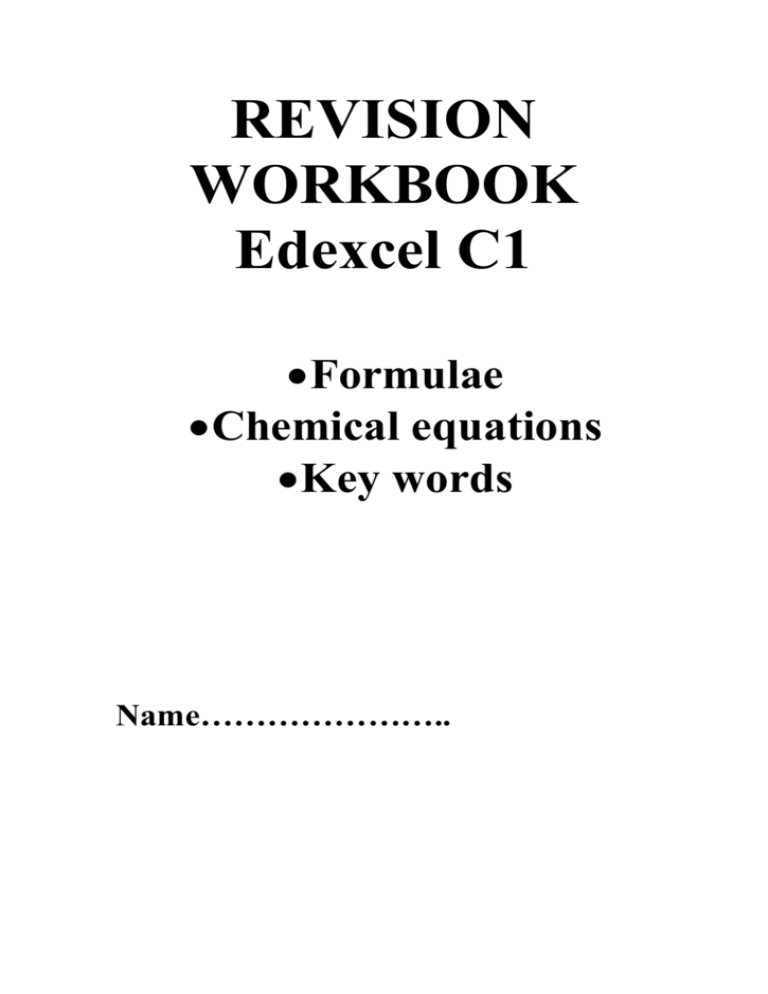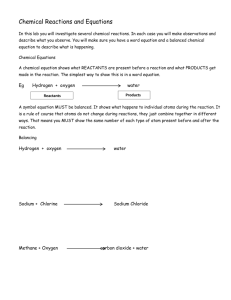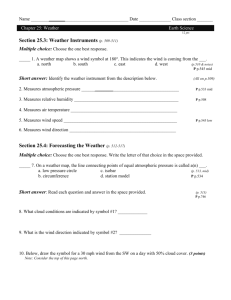File
advertisement

REVISION WORKBOOK Edexcel C1 Formulae Chemical equations Key words Name………………….. FORMULAE and EQUATIONS Write the correct formula. You can use any formula more than once HNO3, CaCO3, Ca(OH) 2, Na 2 CO 3, CO, NH3, CaO , H2SO4, CuCl2, Cu (NO3) 2, CaCl2, AgNO3, HCl Calcium Carbonate Marble Lime water Quick Lime or Calcium Oxide Slaked Lime Sulphuric acid Copper nitrate Calcium Chloride Calcium Hydroxide Ammonia Methane Carbon monoxide Sodium Carbonate Hydrochloric acid Nitric acid Copper Chloride Silver nitrate Limestone equations PRACTICE AND LEARN 1. How do you make a sample of lime water from Lime stone? Do not forget to write the state symbols ( s for solid, l for liquid, g for a gas, aq for aqueous) Answer: 2 STEPS Step 1 : Heat Calcium Carbonate . Word equation Symbol equation This is a ……………………………………….. reaction Step II Add water to Calcium oxide Word equation Symbol equation 2 The product calcium hydroxide dissolves when more water is added. The solution of calcium hydroxide is called ………………………………….. 2. What happens when carbon dioxide is bubbled through a solution of lime water? Another way of asking this question is: Describe a laboratory test for carbon dioxide using lime water. Answer: Lime water goes……………………………………………This is because an insoluble product………………………. is formed. Word equation Symbol equation 3. Equations for heating carbonates Remember heating carbonates is a THERMAL DECOMPOSITION reaction. On heating ALL carbonates (except sodium, potassium carbonates) give CARBON DIOXIDE Try these now Word Calcium Carbonate---------- ………………… Symbol ………………… --------- …………………. + …………………………. Word Zinc Carbonate---------- ………………… Symbol ………………… + ………………………… --------- …………………. + …………………………. Word Copper Carbonate---------- ………………… Symbol ………………… + ………………………… + ………………………… --------- …………………. + …………………………. 3 3. Equation for PRECIPITATION REACTIONS A precipitation reaction is when SOLUBLE substances react together to form an INSOLUBLE product called the precipitate. For soluble substances you need to use the symbol (aq) Silver nitrate and potassium bromide are soluble. They react to make an insoluble cream coloured silver bromide. Word equation ………………………. + ………………….. ……………… +…………….. Symbol equation 4. Equations for Neutralisation Reactions Neutralisation reaction is between an acid and base to make salt and water. A base can be metal hydroxide like sodium hydroxide, a metal oxide like Calcium oxide and a metal carbonate like Calcium carbonate. Acid + Metal Hydroxide --- Salt + Water Acid + Metal Oxide ------- Salt + Water Acid + Metal Carbonate ------- Salt + Water + Carbon dioxide With Sulphuric acid you will get a sulphate salt With Nitric acid you will get a Nitrate salt With Hydrochloric acid You will get a Chloride salt Now Try these Sulphuric acid with Sodium Hydroxide Word equation ………………………. + ………………….. ……………… +…………….. Symbol equation 4 Nitric acid with Copper Oxide Word equation ………………………. + ………………….. ……………… +…………….. Symbol equation Hydrochloric acid with Copper Carbonate Word equation ………………………. + ………………….. ……………… +…………….. Symbol equation Sulphuric acid with Copper Oxide Word equation ………………………. + ………………….. ……………… +…………….. Symbol equation Nitric acid with Copper Oxide Word equation ………………………. + ………………….. ……………… +…………….. Symbol equation Sulphuric acid with Copper carbonate Word equation ………………………. + ………………….. ……………… +…………….. Symbol equation 5 5. for Extraction of metals by reduction Reduction is removal of oxygen from an oxide. Oxidation is addition of oxygen to an element. Metals above Carbon in reactivity series are extracted by reduction with carbon. a) Iron Oxide is reduced by carbon to iron metal. Word equation ………………………. + ………………….. ……………… +…………….. Symbol equation b) Zinc oxide is reduced to zinc by carbon Word equation ………………………. + ………………….. ……………… +…………….. Symbol equation 6. Equations for Combustion of Fuels Complete Combustion of fuels produces carbon dioxide and water. Incomplete combustion can go in three ways Fuel +Oxygen ---- Carbon(soot) +Water Fuel +Oxygen----- Carbon monoxide + water Fuel + Oxygen --- Carbon dioxide+ Carbon monoxide+ Carbon(soot) + water Now try these a) Methane burns in oxygen completely Word equation ………………………. + ………………….. ……………… +…………….. Symbol equation b) Methane burns in insufficient air forming soot. Word equation ………………………. + ………………….. ……………… +…………….. Symbol equation 6 c) Propane ( C3H8) burns in insufficient supply of air forming carbon monoxide and soot and 2 other products. Word equation ………………………. + ………………….. ……………… +…………….. Symbol equation d) Propane burning completely in oxygen Word equation ………………………. + ………………….. ……………… +…………….. Symbol equation e) Butane (C4H10) burning in insufficient oxygen to make two gaseous products. Word equation ………………………. + ………………….. ……………… +…………….. Symbol equation REMEMBER An equation on combustion can be 2 -3 marks where1 mark is for reactants formula, 1 mark for the products formula and 1 mark for balancing. If you are struggling to balance, visit the equation later when you have attempted other questions. Incorrect formula do not score marks for example water Incorrect x correct 7 SECTION II KEY WORDS AND MEANINGS Select the suitable key word to match with its meaning. Part 1 Limestone, Thermal Decomposition, Element, Compound, Precipitate, bases, neutralisation, exothermic, electrolysis, electrolytes, ores, extraction, reduction, corrosion, malleable, ductile, alloy, carats or as fineness, smart material, shape memory alloy, rusting, recycling Key word Meaning Substances which react with acids Corrosion of iron Rocks that contain enough of a compound to extract a metal for profit Breaking down( decomposing) by heat Sedimentary rock mainly made of calcium carbonate A reaction between an acid and a base to make salt and water Made of same type of atoms which can not break further. The process of getting a metal from a compound in a rock by chemical reaction Insoluble product formed when two soluble substances react Two or more different elements chemically joined together Metal is melted and made into something new Surface of metal changes by reaction with oxygen. Metal can be hammered into shape Decomposing compounds by using electricity Mixture of metals 8 Compounds that can be decomposed by electricity Metal can be stretched into wires Removing oxygen from a metal oxide Materials have a property that changes with a change in conditions, usually temperature Alloys which return to the original shape on heating example Nitinol which is an alloy of nickel and aluminium Measure of the purity of gold. Pure gold is 24 carat and has a fineness of 1000 parts per thousand Part II fossil fuels, hydrocarbons, fractional distillation, ignite, viscosity, combustion, Biofuels , Biodiesel , Renewable, Carbon neutral, fuel cell, saturated hydrocarbons, unsaturated, cracking, polymer, monomer, plastics, polymerisation, biodegradable, incinerated, reusing, recycling Key Word Meaning Fuel made from vegetable oils by chemical reaction and mixed with normal diesel Overall does not add carbon dioxide to the atmosphere Burning Fuels which will never run out When monomer molecules react together to form long chain molecules Long chain hydrocarbons are broken into small chain hydrocarbons. 9 Fuels obtained from living organisms or recently dead organisms. Substances whose molecules react together to form polymers Hydrocarbons which have only single bonds between carbon atoms Manufactured polymers Materials in an item are processed and used to make new objects A small device in which hydrogen and oxygen react to produce energy without burning Using an item or material again These are substances made up of thousands of simple repeating units Hydrocarbons with atleast one double bond between two carbon atoms Process of burning the waste Materials which can be decomposed by bacteria Mixture of crude oil is separated into simpler and more useful mixtures of hydrocarbons Set a light These fuels will run out one day How runny a fuel is? Compounds made of hydrogen and carbon only 10 DESCRIBING TESTS (2 MARK QUESTIONS) When describing a test remember to write how will you test (1 mark) and what results do you expect to see ( 1 mark). Tests for gases TEST FOR OXYGEN Bring a glowing splint near the mouth of test tube containing the gas It will relight if the gas is oxygen. TEST FOR HYDROGEN Bring a lighted splint (with flame) near the mouth of test tube containing the gas, if the gas burns with a squeaky pop then the gas is hydrogen TEST FOR CHLORINE Hold a piece of damp blue litmus paper in the mouth of the test tube. If the gas is chlorine then the paper will turn red and then turn white as it is bleached. Test of Unsaturated Hydrocarbons ( double bonds) Test to find out if the compound contains double bonds Add Bromine water which has an orange colour to the hydrocarbon. If Bromine water decolourises ( goes colourless) then the compound has double bonds or is unsaturated. TEST FOR CARBONDIOXIDE When Carbon dioxide is bubbled through a solution of lime water it goes cloudy. Limewater Insoluble Calcium carbonate 11







